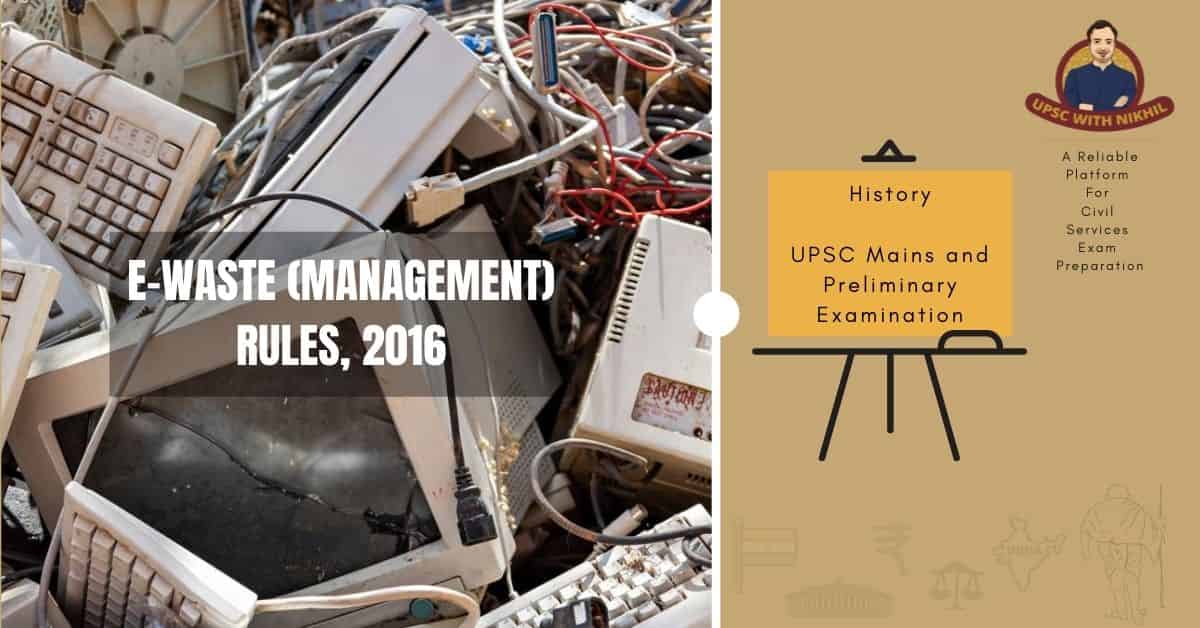E-waste (management) Rules, 2016
E-WASTE (MANAGEMENT) RULES, 2016 - WHAT’S NEW?
• The rules now include additional stakeholders such as the manufacturer, dealer, refurbisher, and Producer Responsibility Organization (PRO). In addition to the equipment listed in Schedule I, the rules now apply to EEE components, consumables, spares, and parts as well.
• A collection mechanism-based approach has been adopted for the collection of e-waste by Producers under Extended Producer Responsibilities, which includes collection centers, collection points, and take-back systems, among other things (EPR).
• An option has been provided for the establishment of PRO, e-waste exchange, e-retailer, and Deposit Refund Scheme as an additional channel for Producers to implement EPR and ensure efficient e-waste channelization.
• The CPCB has introduced a provision for pan-India EPR authorization, which replaces state-by-state EPR authorization.
• In Extended Producer Responsibility - Authorization, the collection and channelization of e-waste shall be in accordance with the targets set forth in Schedule III of the Rules. During the first two years of rule implementation, the collection target for e-waste, which can be measured in number or weight, shall be 30 percent of the waste generation as indicated in the EPR Plan, followed by 40 percent in the third and fourth years, 50 percent in the fifth and sixth years, and 70 percent in the seventh year and beyond.
• The Deposit Refund Scheme has been introduced as an additional economic instrument in which the producer charges an additional amount as a deposit at the time of sale of electrical and electronic equipment and then returns it to the consumer with interest when the end-of-life electrical and electronic equipment is returned.
• The e-waste exchange has been provided as an option in the rules as an independent market instrument or independent electronic system providing services for the sale and purchase of e-waste generated from end-of-life electrical and electronic equipment between agencies or organizations authorized under these rules.
• The manufacturer is now also responsible for collecting e-waste generated during the manufacturing of any electrical or electronic equipment, channeling it for recycling or disposal, and obtaining SPCB authorization.
• If the dealer has been assigned the task of collecting e-waste on behalf of the producer, the dealer must collect the e-waste by providing the consumer with a box and directing it to the producer.
• As per the producer's take back system or deposit refund scheme, the dealer, retailer, or e-retailer shall refund the amount to the e-waste depositor.
• The refurbisher must collect e-waste generated during the refurbishment process and channel it through its collection center to an authorized dismantler or recycler, as well as obtain a one-time authorization from the SPCB.
• In order to ensure the safety, health, and skill development of workers involved in dismantling and recycling operations, the State Government's roles have been added to the Rules.
• In existing and upcoming industrial parks, estates, and industrial clusters, the State Department of Industry or any other government agency authorized in this regard by the State Government is to ensure earmarking or allocation of industrial space or shed for e-waste dismantling and recycling.
• The State Department of Labor, or any other government agency authorized by the State Government in this regard, must ensure that workers involved in dismantling and recycling are recognized and registered; assist in the formation of groups of such workers to facilitate the establishment of dismantling facilities; and conduct industrial skill development activities for workers involved in dismantling and recycling.
• The state government must develop an integrated plan for implementing these provisions effectively and submit an annual report to the Ministry of Environment, Forestry, and Climate Change.
• The transportation of e-waste must follow the manifest system, which requires the trans-porter to carry a document (three copies) prepared by the sender outlining the details.
• Liability for damages caused to the environment or third parties as a result of improper e-waste management, as well as a provision for imposing financial penalties for violations of the Rules, has been added.
• The task of collecting and channeling orphan products to authorized dismantlers or recyclers has been assigned to Urban Local Bodies (Municipal Committee/Council/Corporation).
E-WASTE (MANAGEMENT) AMENDMENT RULES, 2018
• The rule changes were made with the goal of channeling e-waste generated in the country to authorised dismantlers and recyclers, thereby formalizing the e-waste recycling industry.
• The collection targets set forth in the Rules under the Extended Producer Responsibility (EPR) provision have been revised, and new targets have been established for new producers who have recently begun their sales operations.
• The following are some of the key features of the E-waste (Management) Amendment Rules, 2018:
1. The EPR's e-waste collection targets have been revised and will take effect on October 1, 2017. During 2017-18, the collection targets for e-waste in weight will be 10% of the amount of waste generated as indicated in the EPR Plan, with a 10% increase every year until 2023. After 2023, the target has been raised to 70% of the amount of waste generated, as stated in the EPR Plan.
2. Until March 2018, the amount of e-waste collected by producers between 1 October 2016 and 30 September 2017 will be accounted for in the revised EPR targets.
3. E-waste collection targets for new producers, i.e. those whose number of years in business is less than the average product life, have been drafted separately. The products' average lives will be determined by the guidelines issued by the CPCB from time to time.
4. Producer Responsibility Organizations (PROs) must apply for registration with the Central Pollution Control Board (CPCB) in order to carry out the activities outlined in the Rules.
5. Under the Reduction of Hazardous Substances (RoHS) provisions, the government will cover the cost of sampling and testing for the RoHS test. The cost of the test will be borne by the Producers if the product does not comply with RoHS requirements.



